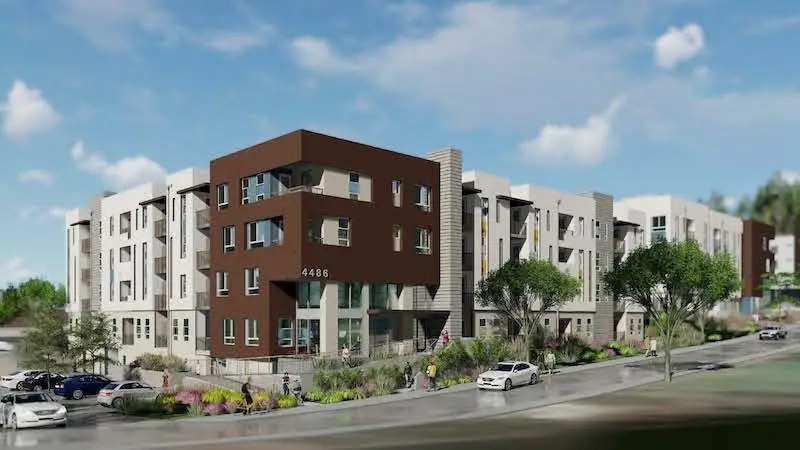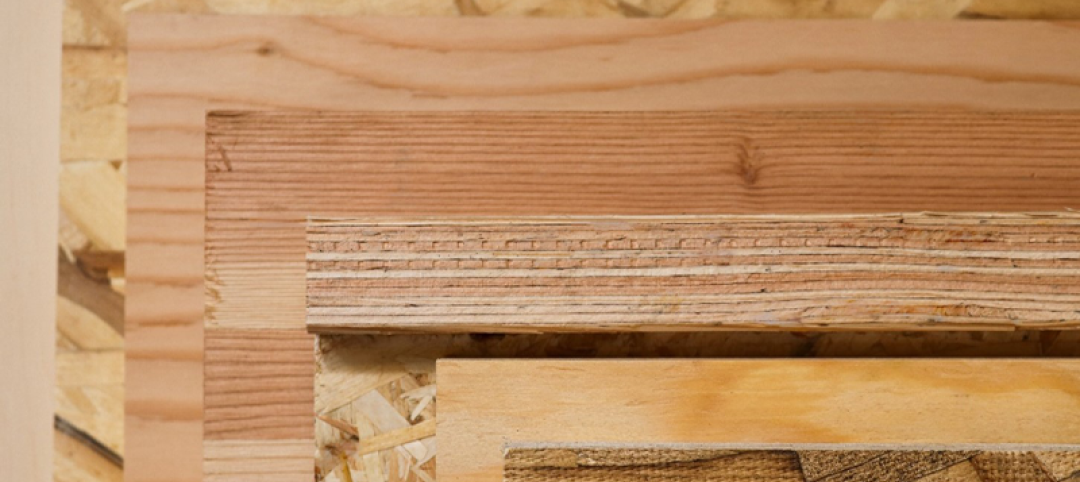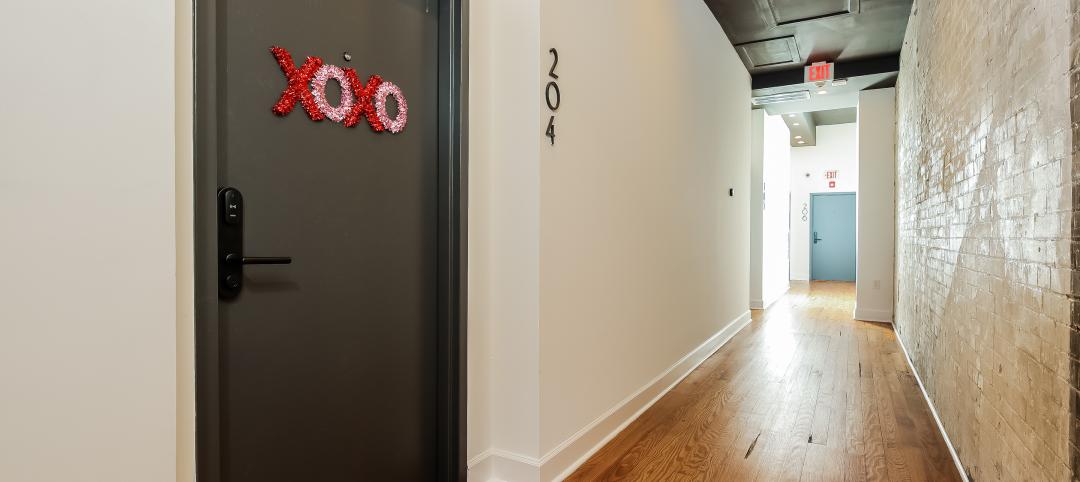Built in 1942, Rose Hill Courts is one of Los Angeles’ oldest public housing complexes. And led by a team that includes the Housing Authority of the City of Los Angeles (HACLA), the developer Related California, and the general contractor R.D. Olson Construction, the first phase of Rose Hill Courts’ redevelopment and expansion is underway to construct two Type V-A four-story wood-frame buildings with 51 and 38 units, respectively, and ground-level surface parking spaces.
Upon completion, this project will nearly double Rose Hill Courts to 185 affordable housing units for low, very low, and extremely low income families, and replace its existing 100 units set on five acres.
The two new buildings in phase one are designed to achieve LEED certification, and their construction is scheduled for completion at the end of next year. Totalling 103,000 sf, the two buildings will offer 51 one-bedroom, 26 two-bedroom, eight three-bedroom, and four four-bedroom apartments. One building will also have a 3,000-sf underground basement that makes use of an adjacent hill.
A GC COMMITTED TO AFFORDABLE HOUSING
R.D. Olson partnered with Withee Malcolm Architects on this project. Resource Environmental Inc., a hazardous material abatement and demolition contractor, performed abatement and demolition work that was completed prior to the financial closing and construction that started in June.
The Rose Hill Courts redevelopment is R.D. Olson’s fourth affordable housing project within a 10-mile radius of Los Angeles. “We bring the right experience along with well-established relationships in the community, and are successfully navigating the challenges of keeping the remaining 70-year-old residences operational during phase one of construction,” says Bill Wilhelm, R.D. Olson’s president.
Also see: L.A.’s component-based interim housing
According to HACLA’s website, phase two of the redevelopment will include 95 affordable apartment homes that target very low and extremely low income residents. Once both phases are completed, the redevelopment will include a 6,300-sf community building with and on-site property management office and social services, and a “Central Park” green space with shaded seating, barbeque grills, courtyards, and children’s play areas with “tot lots” for resident use.
Both phases will feature surface parking, a secured interior bike room, bike racks, entirely new landscaping, lighting, fencing, signage, security features, storm-drain and utility improvements. The new sustainably designed buildings will utilize solar power and the landscaping will include water-efficient irrigation and storm water reuse.
A HOMELESS PROBLEM THAT’S GETTING WORSE
Phase 1 of the redevelopment is financed with $31.8 million in tax-exempt bonds and $13.9 million in private equity raised through the sale of federal low-income housing tax credits. HACLA will provide up to $8.35 million during construction. This phase of redevelopment will also be supported by $15.5 million in funding from the State of California department of Housing and Community Development through the Affordable Housing & Sustainable Communities and Infill Infrastructure Grant programs.
In addition, $8 million in AHSC grant funds were awarded to the City of Los Angeles to provide pedestrian safety upgrades in the immediate neighborhood and improvements in public transportation including six new bus shelters and eight battery electric buses.
The Rose Hill Courts redevelopment is occurring at a time when homelessness in southern California has been rising. On any given night there are more than 66,000 people homeless in Los Angeles County, and 739 homeless died in the county in the first six months of 2021, 20% more than during the same period in 2020. In July, L.A. County approved $527.1 million in funding to battle homelessness in fiscal 2012-22.
Related Stories
Sponsored | Multifamily Housing | Sep 25, 2023
Six3Tile helps The Sherbert Group bring an abandoned Power House back to life
Cladding and Facade Systems | Sep 22, 2023
5 building façade products for your next multifamily project
A building's façade acts as a first impression of the contents within. For the multifamily sector, they have the potential to draw in tenants on aesthetics alone.
Sponsored | Multifamily Housing | Sep 21, 2023
5 Helpful Resources for Designing & Building with Engineered Wood
From in-depth, technical publications with detailed illustrations and examples to in-person consultations with engineered wood specialists, APA offers a host of helpful resources for commercial designers and installers working with engineered wood.
MFPRO+ Blog | Sep 21, 2023
The benefits of strategic multifamily housing repositioning
With the rapid increase in new multifamily housing developments, owners of existing assets face increasing competition. As their assets age and the number of new developments increases seemingly day-by-day, developers will inevitably have to find a way to stay relevant.
Mixed-Use | Sep 20, 2023
Tampa Bay Rays, Hines finalize deal for a stadium-anchored multiuse district in St. Petersburg, Fla.
The Tampa Bay Rays Major League Baseball team announced that it has reached an agreement with St. Petersburg and Pinellas County on a $6.5 billion, 86-acre mixed-use development that will include a new 30,000-seat ballpark and an array of office, housing, hotel, retail, and restaurant space totaling 8 million sf.
Engineers | Sep 15, 2023
NIST investigation of Champlain Towers South collapse indicates no sinkhole
Investigators from the National Institute of Standards and Technology (NIST) say they have found no evidence of underground voids on the site of the Champlain Towers South collapse, according to a new NIST report. The team of investigators have studied the site’s subsurface conditions to determine if sinkholes or excessive settling of the pile foundations might have caused the collapse.
MFPRO+ Research | Sep 11, 2023
Conversions of multifamily dwellings to ‘mansions’ leading to dwindling affordable stock
Small multifamily homes have historically provided inexpensive housing for renters and buyers, but developers have converted many of them in recent decades into larger, single-family units. This has worsened the affordable housing crisis, say researchers.
Adaptive Reuse | Aug 31, 2023
New York City creates team to accelerate office-to-residential conversions
New York City has a new Office Conversion Accelerator Team that provides a single point of contact within city government to help speed adaptive reuse projects. Projects that create 50 or more housing units from office buildings are eligible for this new program.
Multifamily Housing | Aug 24, 2023
A multifamily design for multigenerational living
KTGY’s Family Flat concept showcases the benefits of multigenerational living through a multifamily design lens.

















